History of Treatment: Indigenous Australians Reflection Essay
VerifiedAdded on 2022/12/30
|8
|1922
|86
Essay
AI Summary
This essay provides a reflective analysis of the historical treatment of Indigenous Australians, spanning over the last century. The paper employs the DIEP framework (Describe, Interpret, Evaluate, Plan) to examine the injustices faced by Indigenous Australians, including health disparities, government policies, and ethical considerations. The author reflects on the impact of historical events on ethical practices in engineering and discusses the implications of the treatment on the health and well-being of the indigenous population. The essay explores the social and ethical dimensions of historical events, and the application of the DIEP framework to evaluate the past, interpret its influence on the present, and plan for more equitable and ethical practices in the future. The author highlights issues such as malnutrition, disease, violence, and suicide rates, and their impact on the indigenous community. The essay concludes by emphasizing the importance of ethical practices and the role of the government in promoting the welfare of all individuals.
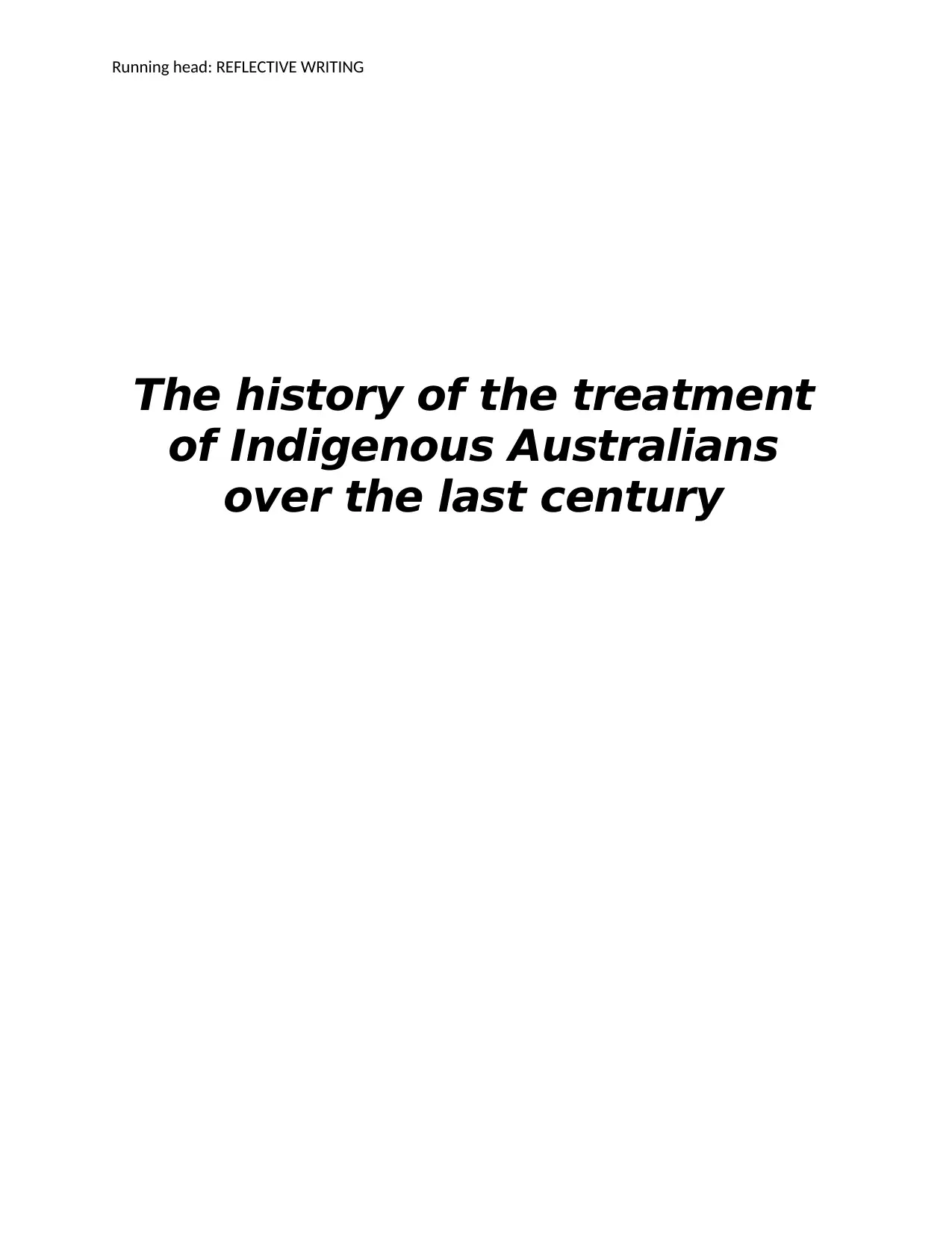
Running head: REFLECTIVE WRITING
The history of the treatment
of Indigenous Australians
over the last century
The history of the treatment
of Indigenous Australians
over the last century
Paraphrase This Document
Need a fresh take? Get an instant paraphrase of this document with our AI Paraphraser
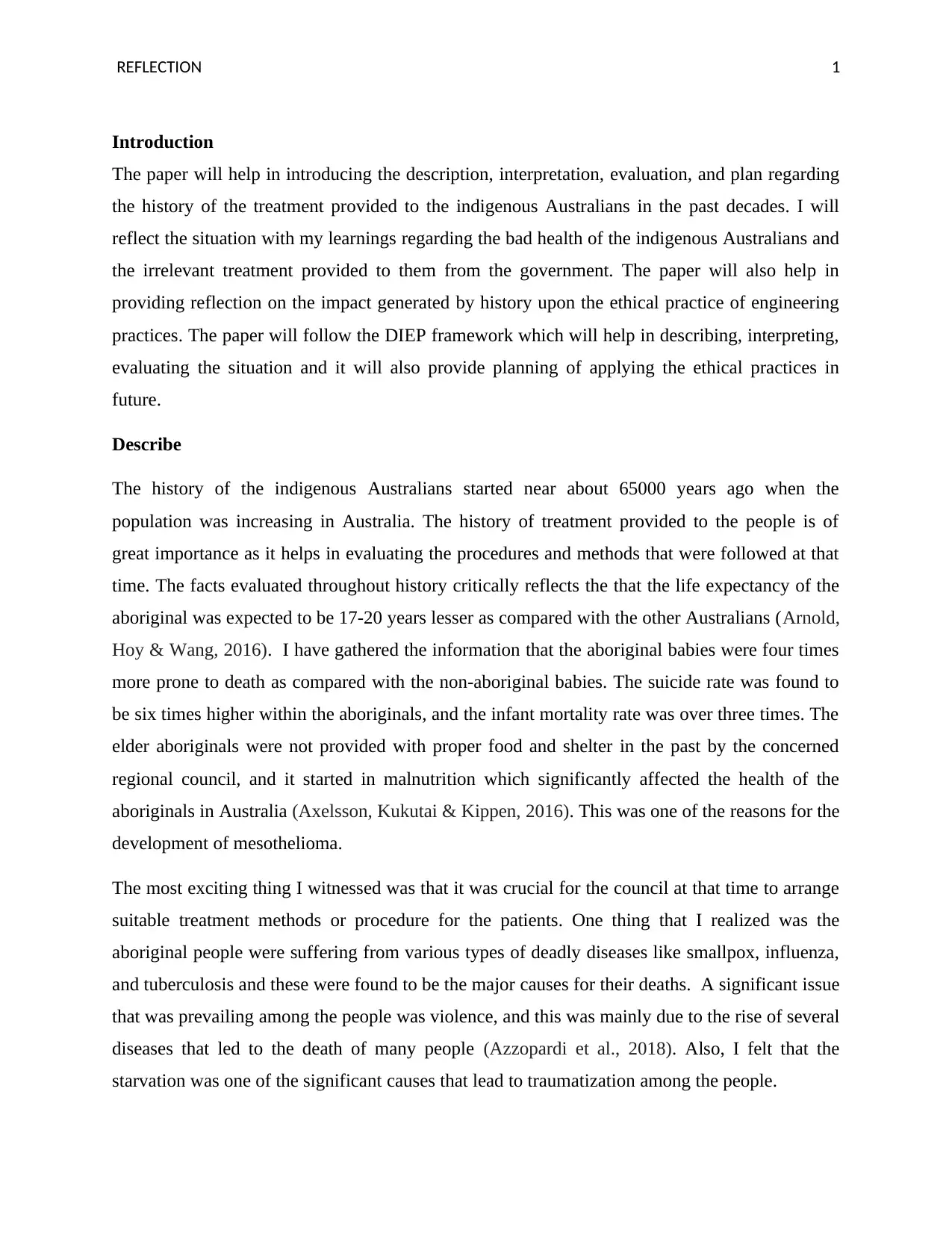
REFLECTION 1
Introduction
The paper will help in introducing the description, interpretation, evaluation, and plan regarding
the history of the treatment provided to the indigenous Australians in the past decades. I will
reflect the situation with my learnings regarding the bad health of the indigenous Australians and
the irrelevant treatment provided to them from the government. The paper will also help in
providing reflection on the impact generated by history upon the ethical practice of engineering
practices. The paper will follow the DIEP framework which will help in describing, interpreting,
evaluating the situation and it will also provide planning of applying the ethical practices in
future.
Describe
The history of the indigenous Australians started near about 65000 years ago when the
population was increasing in Australia. The history of treatment provided to the people is of
great importance as it helps in evaluating the procedures and methods that were followed at that
time. The facts evaluated throughout history critically reflects the that the life expectancy of the
aboriginal was expected to be 17-20 years lesser as compared with the other Australians (Arnold,
Hoy & Wang, 2016). I have gathered the information that the aboriginal babies were four times
more prone to death as compared with the non-aboriginal babies. The suicide rate was found to
be six times higher within the aboriginals, and the infant mortality rate was over three times. The
elder aboriginals were not provided with proper food and shelter in the past by the concerned
regional council, and it started in malnutrition which significantly affected the health of the
aboriginals in Australia (Axelsson, Kukutai & Kippen, 2016). This was one of the reasons for the
development of mesothelioma.
The most exciting thing I witnessed was that it was crucial for the council at that time to arrange
suitable treatment methods or procedure for the patients. One thing that I realized was the
aboriginal people were suffering from various types of deadly diseases like smallpox, influenza,
and tuberculosis and these were found to be the major causes for their deaths. A significant issue
that was prevailing among the people was violence, and this was mainly due to the rise of several
diseases that led to the death of many people (Azzopardi et al., 2018). Also, I felt that the
starvation was one of the significant causes that lead to traumatization among the people.
Introduction
The paper will help in introducing the description, interpretation, evaluation, and plan regarding
the history of the treatment provided to the indigenous Australians in the past decades. I will
reflect the situation with my learnings regarding the bad health of the indigenous Australians and
the irrelevant treatment provided to them from the government. The paper will also help in
providing reflection on the impact generated by history upon the ethical practice of engineering
practices. The paper will follow the DIEP framework which will help in describing, interpreting,
evaluating the situation and it will also provide planning of applying the ethical practices in
future.
Describe
The history of the indigenous Australians started near about 65000 years ago when the
population was increasing in Australia. The history of treatment provided to the people is of
great importance as it helps in evaluating the procedures and methods that were followed at that
time. The facts evaluated throughout history critically reflects the that the life expectancy of the
aboriginal was expected to be 17-20 years lesser as compared with the other Australians (Arnold,
Hoy & Wang, 2016). I have gathered the information that the aboriginal babies were four times
more prone to death as compared with the non-aboriginal babies. The suicide rate was found to
be six times higher within the aboriginals, and the infant mortality rate was over three times. The
elder aboriginals were not provided with proper food and shelter in the past by the concerned
regional council, and it started in malnutrition which significantly affected the health of the
aboriginals in Australia (Axelsson, Kukutai & Kippen, 2016). This was one of the reasons for the
development of mesothelioma.
The most exciting thing I witnessed was that it was crucial for the council at that time to arrange
suitable treatment methods or procedure for the patients. One thing that I realized was the
aboriginal people were suffering from various types of deadly diseases like smallpox, influenza,
and tuberculosis and these were found to be the major causes for their deaths. A significant issue
that was prevailing among the people was violence, and this was mainly due to the rise of several
diseases that led to the death of many people (Azzopardi et al., 2018). Also, I felt that the
starvation was one of the significant causes that lead to traumatization among the people.

REFLECTION 2
⊘ This is a preview!⊘
Do you want full access?
Subscribe today to unlock all pages.

Trusted by 1+ million students worldwide
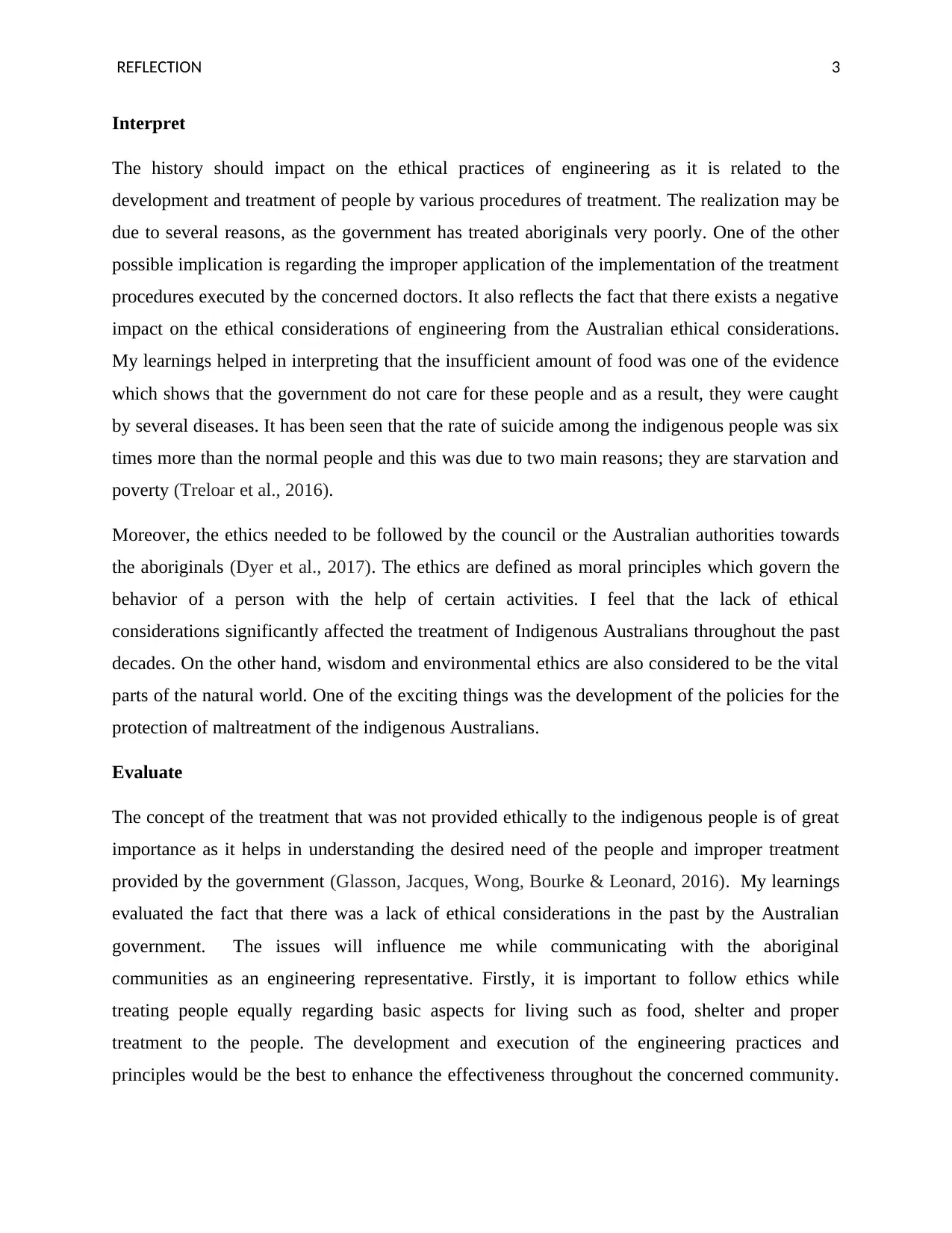
REFLECTION 3
Interpret
The history should impact on the ethical practices of engineering as it is related to the
development and treatment of people by various procedures of treatment. The realization may be
due to several reasons, as the government has treated aboriginals very poorly. One of the other
possible implication is regarding the improper application of the implementation of the treatment
procedures executed by the concerned doctors. It also reflects the fact that there exists a negative
impact on the ethical considerations of engineering from the Australian ethical considerations.
My learnings helped in interpreting that the insufficient amount of food was one of the evidence
which shows that the government do not care for these people and as a result, they were caught
by several diseases. It has been seen that the rate of suicide among the indigenous people was six
times more than the normal people and this was due to two main reasons; they are starvation and
poverty (Treloar et al., 2016).
Moreover, the ethics needed to be followed by the council or the Australian authorities towards
the aboriginals (Dyer et al., 2017). The ethics are defined as moral principles which govern the
behavior of a person with the help of certain activities. I feel that the lack of ethical
considerations significantly affected the treatment of Indigenous Australians throughout the past
decades. On the other hand, wisdom and environmental ethics are also considered to be the vital
parts of the natural world. One of the exciting things was the development of the policies for the
protection of maltreatment of the indigenous Australians.
Evaluate
The concept of the treatment that was not provided ethically to the indigenous people is of great
importance as it helps in understanding the desired need of the people and improper treatment
provided by the government (Glasson, Jacques, Wong, Bourke & Leonard, 2016). My learnings
evaluated the fact that there was a lack of ethical considerations in the past by the Australian
government. The issues will influence me while communicating with the aboriginal
communities as an engineering representative. Firstly, it is important to follow ethics while
treating people equally regarding basic aspects for living such as food, shelter and proper
treatment to the people. The development and execution of the engineering practices and
principles would be the best to enhance the effectiveness throughout the concerned community.
Interpret
The history should impact on the ethical practices of engineering as it is related to the
development and treatment of people by various procedures of treatment. The realization may be
due to several reasons, as the government has treated aboriginals very poorly. One of the other
possible implication is regarding the improper application of the implementation of the treatment
procedures executed by the concerned doctors. It also reflects the fact that there exists a negative
impact on the ethical considerations of engineering from the Australian ethical considerations.
My learnings helped in interpreting that the insufficient amount of food was one of the evidence
which shows that the government do not care for these people and as a result, they were caught
by several diseases. It has been seen that the rate of suicide among the indigenous people was six
times more than the normal people and this was due to two main reasons; they are starvation and
poverty (Treloar et al., 2016).
Moreover, the ethics needed to be followed by the council or the Australian authorities towards
the aboriginals (Dyer et al., 2017). The ethics are defined as moral principles which govern the
behavior of a person with the help of certain activities. I feel that the lack of ethical
considerations significantly affected the treatment of Indigenous Australians throughout the past
decades. On the other hand, wisdom and environmental ethics are also considered to be the vital
parts of the natural world. One of the exciting things was the development of the policies for the
protection of maltreatment of the indigenous Australians.
Evaluate
The concept of the treatment that was not provided ethically to the indigenous people is of great
importance as it helps in understanding the desired need of the people and improper treatment
provided by the government (Glasson, Jacques, Wong, Bourke & Leonard, 2016). My learnings
evaluated the fact that there was a lack of ethical considerations in the past by the Australian
government. The issues will influence me while communicating with the aboriginal
communities as an engineering representative. Firstly, it is important to follow ethics while
treating people equally regarding basic aspects for living such as food, shelter and proper
treatment to the people. The development and execution of the engineering practices and
principles would be the best to enhance the effectiveness throughout the concerned community.
Paraphrase This Document
Need a fresh take? Get an instant paraphrase of this document with our AI Paraphraser
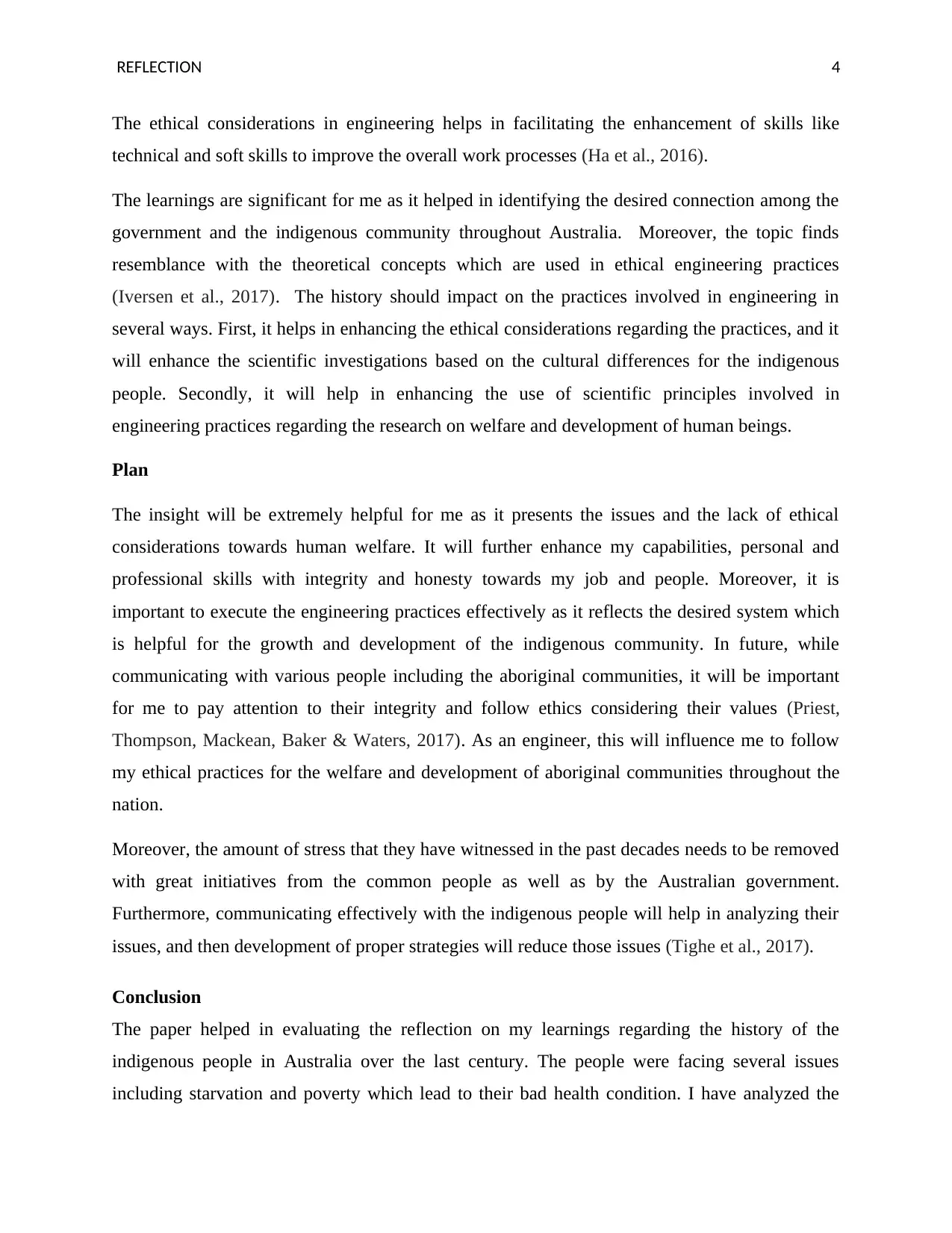
REFLECTION 4
The ethical considerations in engineering helps in facilitating the enhancement of skills like
technical and soft skills to improve the overall work processes (Ha et al., 2016).
The learnings are significant for me as it helped in identifying the desired connection among the
government and the indigenous community throughout Australia. Moreover, the topic finds
resemblance with the theoretical concepts which are used in ethical engineering practices
(Iversen et al., 2017). The history should impact on the practices involved in engineering in
several ways. First, it helps in enhancing the ethical considerations regarding the practices, and it
will enhance the scientific investigations based on the cultural differences for the indigenous
people. Secondly, it will help in enhancing the use of scientific principles involved in
engineering practices regarding the research on welfare and development of human beings.
Plan
The insight will be extremely helpful for me as it presents the issues and the lack of ethical
considerations towards human welfare. It will further enhance my capabilities, personal and
professional skills with integrity and honesty towards my job and people. Moreover, it is
important to execute the engineering practices effectively as it reflects the desired system which
is helpful for the growth and development of the indigenous community. In future, while
communicating with various people including the aboriginal communities, it will be important
for me to pay attention to their integrity and follow ethics considering their values (Priest,
Thompson, Mackean, Baker & Waters, 2017). As an engineer, this will influence me to follow
my ethical practices for the welfare and development of aboriginal communities throughout the
nation.
Moreover, the amount of stress that they have witnessed in the past decades needs to be removed
with great initiatives from the common people as well as by the Australian government.
Furthermore, communicating effectively with the indigenous people will help in analyzing their
issues, and then development of proper strategies will reduce those issues (Tighe et al., 2017).
Conclusion
The paper helped in evaluating the reflection on my learnings regarding the history of the
indigenous people in Australia over the last century. The people were facing several issues
including starvation and poverty which lead to their bad health condition. I have analyzed the
The ethical considerations in engineering helps in facilitating the enhancement of skills like
technical and soft skills to improve the overall work processes (Ha et al., 2016).
The learnings are significant for me as it helped in identifying the desired connection among the
government and the indigenous community throughout Australia. Moreover, the topic finds
resemblance with the theoretical concepts which are used in ethical engineering practices
(Iversen et al., 2017). The history should impact on the practices involved in engineering in
several ways. First, it helps in enhancing the ethical considerations regarding the practices, and it
will enhance the scientific investigations based on the cultural differences for the indigenous
people. Secondly, it will help in enhancing the use of scientific principles involved in
engineering practices regarding the research on welfare and development of human beings.
Plan
The insight will be extremely helpful for me as it presents the issues and the lack of ethical
considerations towards human welfare. It will further enhance my capabilities, personal and
professional skills with integrity and honesty towards my job and people. Moreover, it is
important to execute the engineering practices effectively as it reflects the desired system which
is helpful for the growth and development of the indigenous community. In future, while
communicating with various people including the aboriginal communities, it will be important
for me to pay attention to their integrity and follow ethics considering their values (Priest,
Thompson, Mackean, Baker & Waters, 2017). As an engineer, this will influence me to follow
my ethical practices for the welfare and development of aboriginal communities throughout the
nation.
Moreover, the amount of stress that they have witnessed in the past decades needs to be removed
with great initiatives from the common people as well as by the Australian government.
Furthermore, communicating effectively with the indigenous people will help in analyzing their
issues, and then development of proper strategies will reduce those issues (Tighe et al., 2017).
Conclusion
The paper helped in evaluating the reflection on my learnings regarding the history of the
indigenous people in Australia over the last century. The people were facing several issues
including starvation and poverty which lead to their bad health condition. I have analyzed the
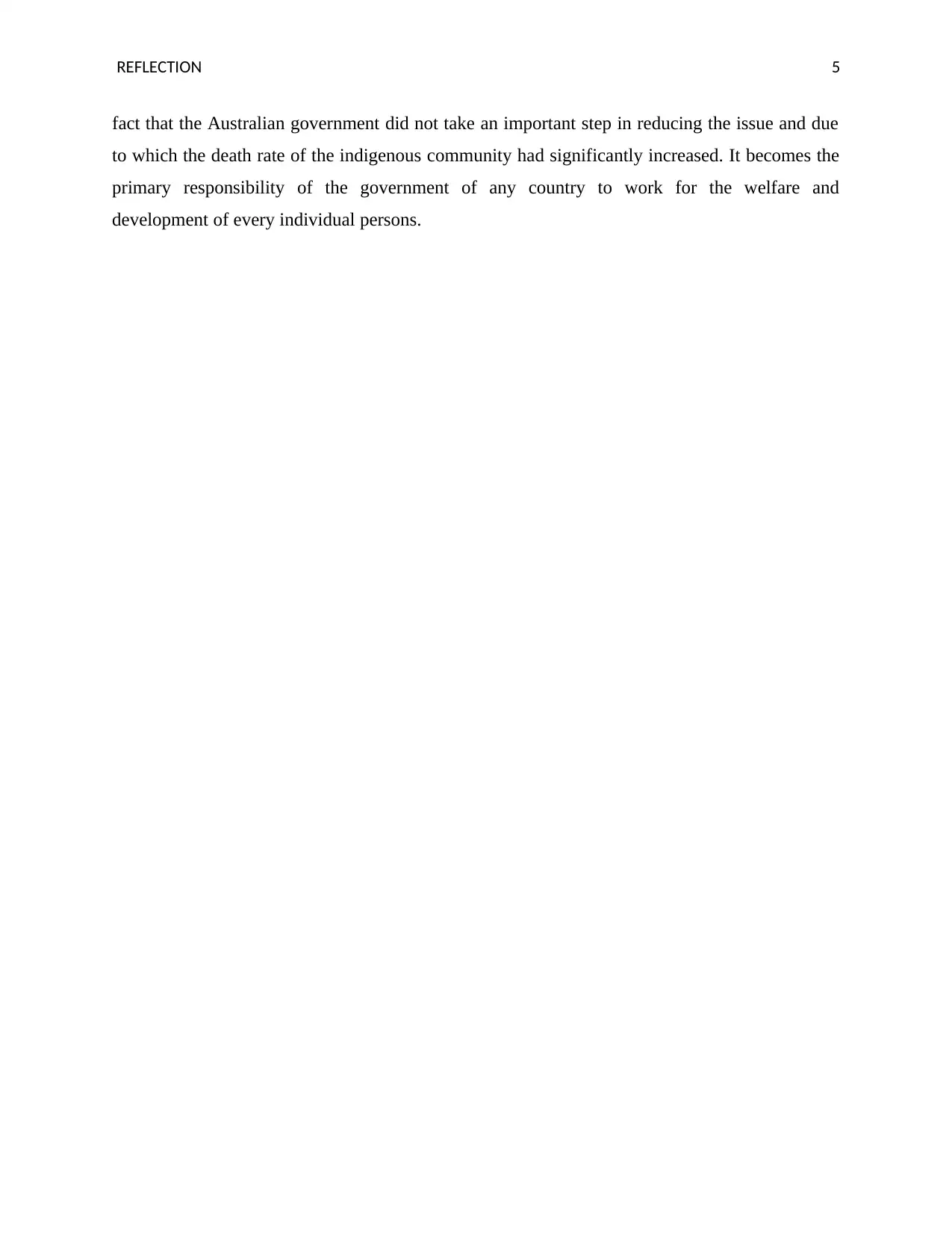
REFLECTION 5
fact that the Australian government did not take an important step in reducing the issue and due
to which the death rate of the indigenous community had significantly increased. It becomes the
primary responsibility of the government of any country to work for the welfare and
development of every individual persons.
fact that the Australian government did not take an important step in reducing the issue and due
to which the death rate of the indigenous community had significantly increased. It becomes the
primary responsibility of the government of any country to work for the welfare and
development of every individual persons.
⊘ This is a preview!⊘
Do you want full access?
Subscribe today to unlock all pages.

Trusted by 1+ million students worldwide
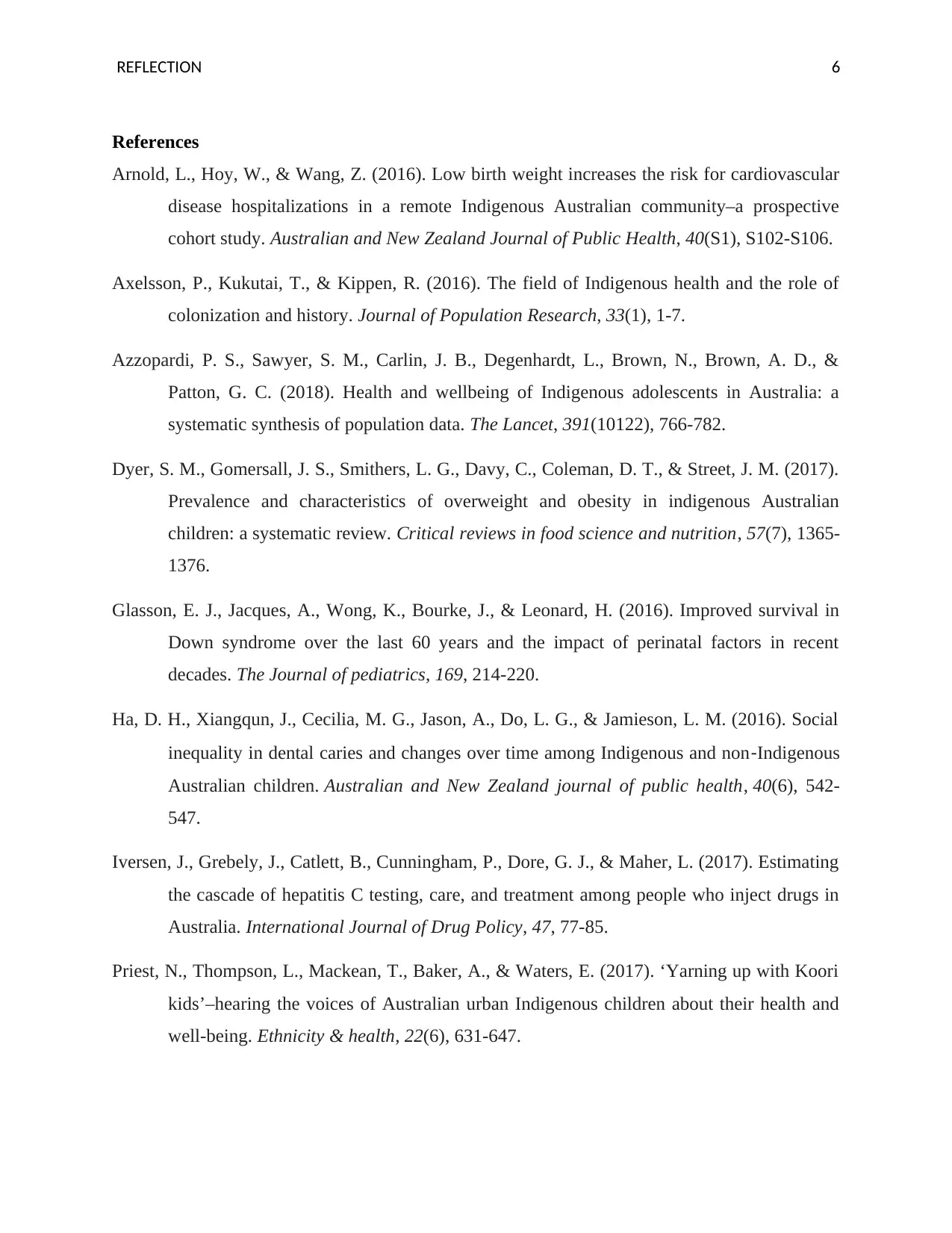
REFLECTION 6
References
Arnold, L., Hoy, W., & Wang, Z. (2016). Low birth weight increases the risk for cardiovascular
disease hospitalizations in a remote Indigenous Australian community–a prospective
cohort study. Australian and New Zealand Journal of Public Health, 40(S1), S102-S106.
Axelsson, P., Kukutai, T., & Kippen, R. (2016). The field of Indigenous health and the role of
colonization and history. Journal of Population Research, 33(1), 1-7.
Azzopardi, P. S., Sawyer, S. M., Carlin, J. B., Degenhardt, L., Brown, N., Brown, A. D., &
Patton, G. C. (2018). Health and wellbeing of Indigenous adolescents in Australia: a
systematic synthesis of population data. The Lancet, 391(10122), 766-782.
Dyer, S. M., Gomersall, J. S., Smithers, L. G., Davy, C., Coleman, D. T., & Street, J. M. (2017).
Prevalence and characteristics of overweight and obesity in indigenous Australian
children: a systematic review. Critical reviews in food science and nutrition, 57(7), 1365-
1376.
Glasson, E. J., Jacques, A., Wong, K., Bourke, J., & Leonard, H. (2016). Improved survival in
Down syndrome over the last 60 years and the impact of perinatal factors in recent
decades. The Journal of pediatrics, 169, 214-220.
Ha, D. H., Xiangqun, J., Cecilia, M. G., Jason, A., Do, L. G., & Jamieson, L. M. (2016). Social
inequality in dental caries and changes over time among Indigenous and non‐Indigenous
Australian children. Australian and New Zealand journal of public health, 40(6), 542-
547.
Iversen, J., Grebely, J., Catlett, B., Cunningham, P., Dore, G. J., & Maher, L. (2017). Estimating
the cascade of hepatitis C testing, care, and treatment among people who inject drugs in
Australia. International Journal of Drug Policy, 47, 77-85.
Priest, N., Thompson, L., Mackean, T., Baker, A., & Waters, E. (2017). ‘Yarning up with Koori
kids’–hearing the voices of Australian urban Indigenous children about their health and
well-being. Ethnicity & health, 22(6), 631-647.
References
Arnold, L., Hoy, W., & Wang, Z. (2016). Low birth weight increases the risk for cardiovascular
disease hospitalizations in a remote Indigenous Australian community–a prospective
cohort study. Australian and New Zealand Journal of Public Health, 40(S1), S102-S106.
Axelsson, P., Kukutai, T., & Kippen, R. (2016). The field of Indigenous health and the role of
colonization and history. Journal of Population Research, 33(1), 1-7.
Azzopardi, P. S., Sawyer, S. M., Carlin, J. B., Degenhardt, L., Brown, N., Brown, A. D., &
Patton, G. C. (2018). Health and wellbeing of Indigenous adolescents in Australia: a
systematic synthesis of population data. The Lancet, 391(10122), 766-782.
Dyer, S. M., Gomersall, J. S., Smithers, L. G., Davy, C., Coleman, D. T., & Street, J. M. (2017).
Prevalence and characteristics of overweight and obesity in indigenous Australian
children: a systematic review. Critical reviews in food science and nutrition, 57(7), 1365-
1376.
Glasson, E. J., Jacques, A., Wong, K., Bourke, J., & Leonard, H. (2016). Improved survival in
Down syndrome over the last 60 years and the impact of perinatal factors in recent
decades. The Journal of pediatrics, 169, 214-220.
Ha, D. H., Xiangqun, J., Cecilia, M. G., Jason, A., Do, L. G., & Jamieson, L. M. (2016). Social
inequality in dental caries and changes over time among Indigenous and non‐Indigenous
Australian children. Australian and New Zealand journal of public health, 40(6), 542-
547.
Iversen, J., Grebely, J., Catlett, B., Cunningham, P., Dore, G. J., & Maher, L. (2017). Estimating
the cascade of hepatitis C testing, care, and treatment among people who inject drugs in
Australia. International Journal of Drug Policy, 47, 77-85.
Priest, N., Thompson, L., Mackean, T., Baker, A., & Waters, E. (2017). ‘Yarning up with Koori
kids’–hearing the voices of Australian urban Indigenous children about their health and
well-being. Ethnicity & health, 22(6), 631-647.
Paraphrase This Document
Need a fresh take? Get an instant paraphrase of this document with our AI Paraphraser
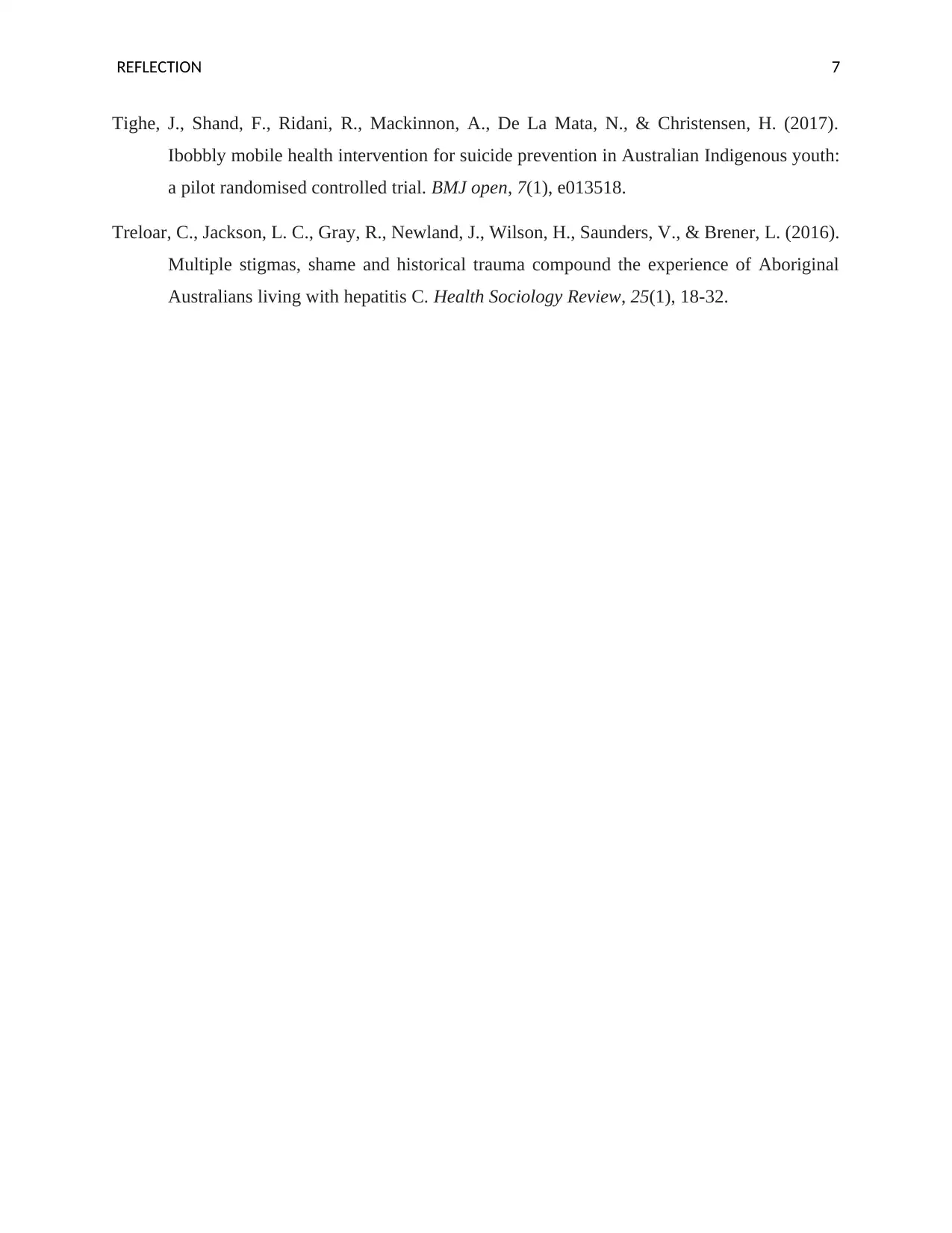
REFLECTION 7
Tighe, J., Shand, F., Ridani, R., Mackinnon, A., De La Mata, N., & Christensen, H. (2017).
Ibobbly mobile health intervention for suicide prevention in Australian Indigenous youth:
a pilot randomised controlled trial. BMJ open, 7(1), e013518.
Treloar, C., Jackson, L. C., Gray, R., Newland, J., Wilson, H., Saunders, V., & Brener, L. (2016).
Multiple stigmas, shame and historical trauma compound the experience of Aboriginal
Australians living with hepatitis C. Health Sociology Review, 25(1), 18-32.
Tighe, J., Shand, F., Ridani, R., Mackinnon, A., De La Mata, N., & Christensen, H. (2017).
Ibobbly mobile health intervention for suicide prevention in Australian Indigenous youth:
a pilot randomised controlled trial. BMJ open, 7(1), e013518.
Treloar, C., Jackson, L. C., Gray, R., Newland, J., Wilson, H., Saunders, V., & Brener, L. (2016).
Multiple stigmas, shame and historical trauma compound the experience of Aboriginal
Australians living with hepatitis C. Health Sociology Review, 25(1), 18-32.
1 out of 8
Related Documents
Your All-in-One AI-Powered Toolkit for Academic Success.
+13062052269
info@desklib.com
Available 24*7 on WhatsApp / Email
![[object Object]](/_next/static/media/star-bottom.7253800d.svg)
Unlock your academic potential
Copyright © 2020–2025 A2Z Services. All Rights Reserved. Developed and managed by ZUCOL.





